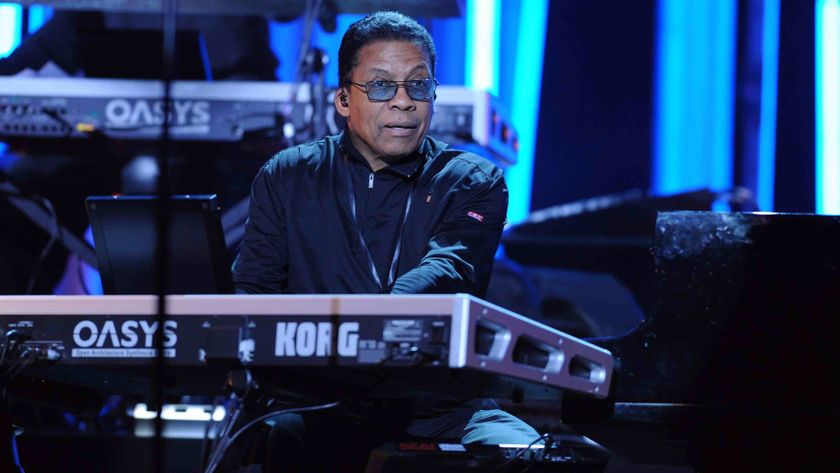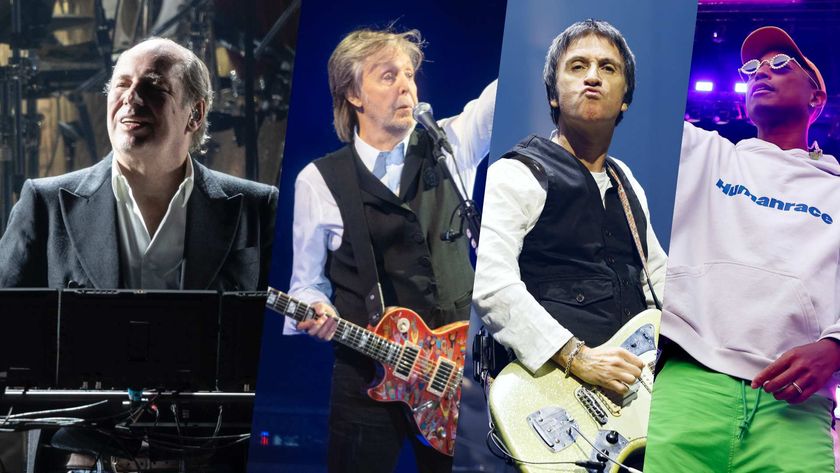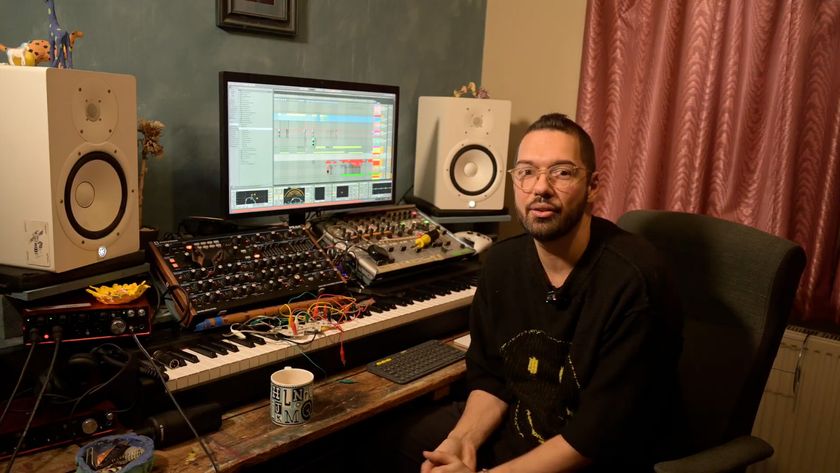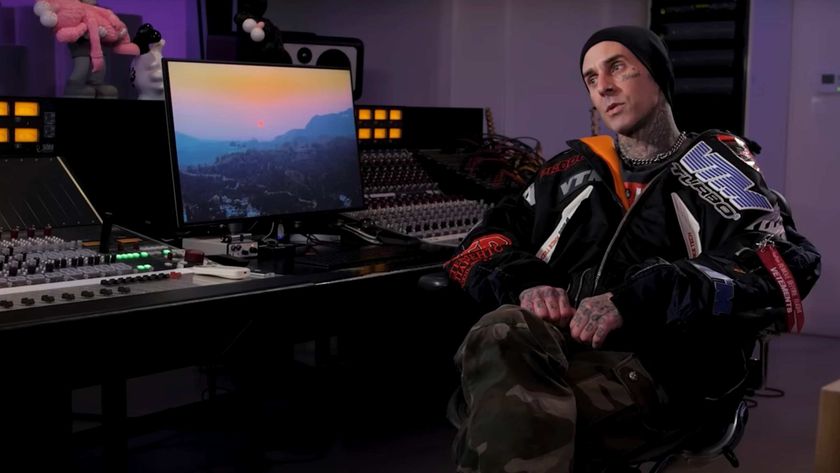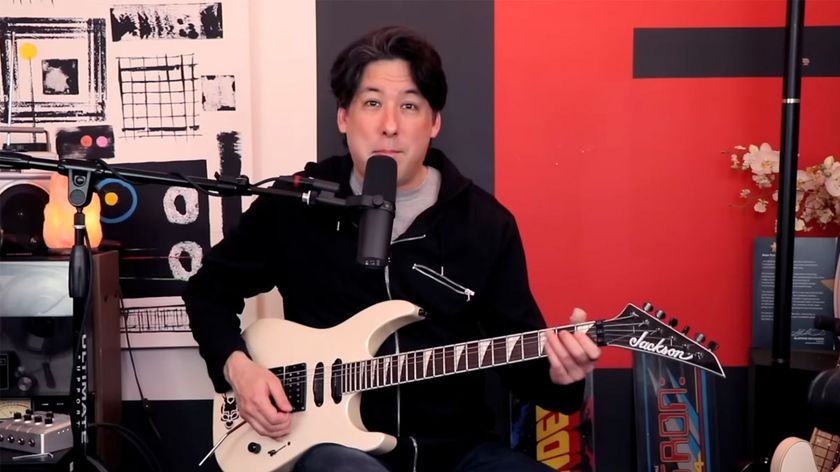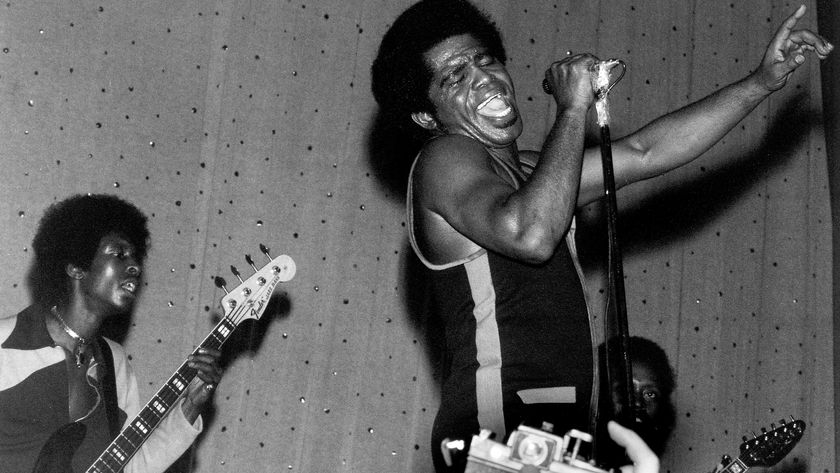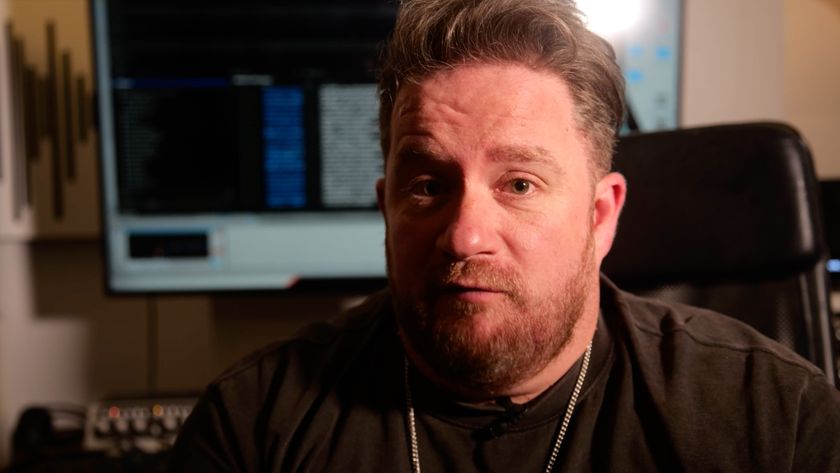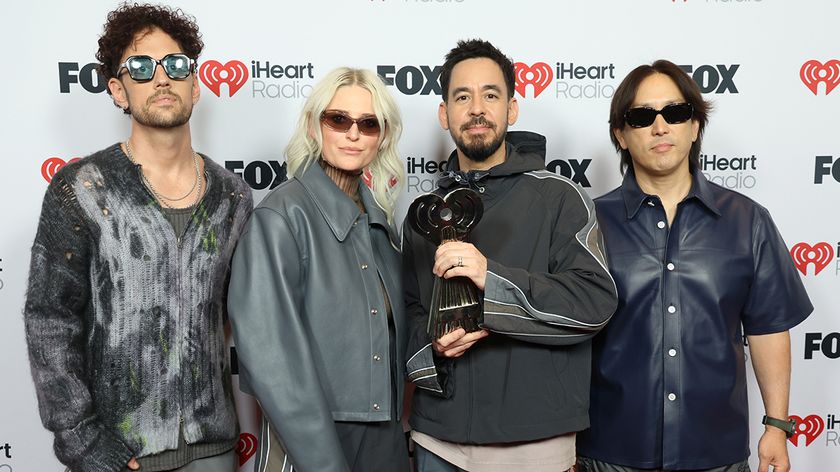
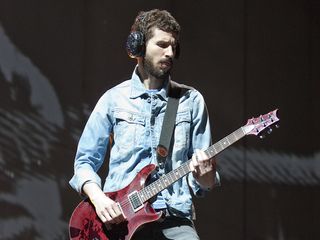
Brad Delson constructs (and deconstructs) walls of guitar goodness on Linkin Park's new album, LIVING THINGS. © Paul Hebert/Corbis
The problem with most albums is that the songs are dead before they're even recorded. Endless demoing and jamming embalms the hot blood of ideas. And should a still-smoldering tune manage to survive long enough to make it to the tracking stage, the repetition of takes - a cinch now that digital has all but replaced tape - is sure to finish the job.
Songs that spring forth like inspired improvisation abound on Linkin Park's punchy and to-the-point fifth album, LIVING THINGS, a raucous 10-song collection that dials back the experimental moodiness of 2010's A Thousand Suns and reintroduces the guitar grit and propulsive force of the band's earliest works.
The six-member ensemble (vocalist Chester Bennington, guitarist Brad Delson, drummer Rob Bourdon, bassist Dave "Phoenix" Farrell, DJ/keyboardist Joe Hahn and guitarist-vocalist Mike Shinoda) resumed the pattern they established with producer Rick Rubin following 2007's Minutes To Midnight: musical bits and pieces are born in the studio, seized upon and turned into songs before the juice can be beaten out of them.
LIVING THINGS is the perfect kind of knockout album - lyrically rich, sonically scalding and full of sharp left turns (a trio of folk-inspired cuts) that pay off in dramatic and surprising ways.
Brad Delson sat down with MusicRadar to talk how the band captured "moments of inspiration" on the new set, when guitars should sound like guitars (and when they shouldn't) and how he rates himself as a lead singer.
The album is fairly short. As they say, it's "all killer, no filler." [Delson laughs] Is that what you guys had in mind?
Get the MusicRadar Newsletter
Want all the hottest music and gear news, reviews, deals, features and more, direct to your inbox? Sign up here.
"Yeah, in fact, I went back and took a look at Hybrid Theory and Meteora because I remember those albums were to the point. I remember they were succinct, but I didn't remember how it all broke down. It surprised me how short they were. I think the records were 35 and 36 minutes long. We were kind of looking at the body of work we had cued up, and with some rough sequences and segues, I think it was somewhere in that range. I thought, Oh, maybe that's a good sign."
Because bands can fit so much information on CDs, do you think they sometimes tend to wear out the welcome?
"Yeah, for sure. I mean, it depends on what kind of album it is. With our last album, A Thousand Suns, which is much more experimental and psychedelic, part of the spirit of that record was expansive. We called some of those songs 'journeys' - you know, where there's, like, three suites. That made for a longer record, so there was purpose to it.
"Now it's more digital, so I guess you can have as many tracks as you want. You see the spirit of 'more is more,' and I don't think that's the case. My favorite albums, I can listen to them from beginning to end. Some of the best ones are over before you know it, and then you just start over again."
With LIVING THINGS, it's been said that the band felt more comfortable revisiting their past, embracing the earlier sound. What led to that?
"It's definitely true that we started making our third record, Minutes To Midnight, before we knew it was going to be called Minutes To Midnight. We wanted to break out of that primary sound or mode that people associated with the band, because part of the inherent identity of the band is to be able to play in different spaces and mix different genres. That doesn't always mean you're mixing the same three ingredients; it means any of the ingredients that you want to use and are comfortable using. On Minutes To Midnight, we used different ingredients.
"On that record and on A Thousand Suns, which was that to the enth, pushing what we could do with a song - you know, a song didn't have to be two and a half or three minutes; the structures could be different; the interludes played a more important part - ultimately we found, with this record, that we didn't need to move away from anything. It was actually more of a synergy, like, 'OK, cool, we want to keep pushing the envelope with progressive sounds and ideas.' And at the same time, things that sounded like the first two records weren't turning us off. It was like, 'Oh yeah, those things feel good again.'"
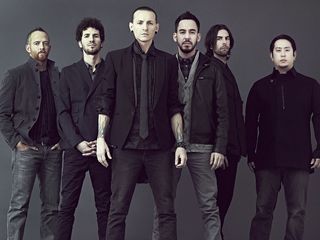
Linkin Park are (from left to right), Dave "Phoenix" Farrell, Brad Delson, Chester Bennington, Mike Shinoda, Rob Bourdon and Joe Hahn. © James Minchin
The guitars are a lot heavier on the new album.
"Yeah, there's a lot more guitar work. Some of the heavier guitar energy has a more prominent role. I think some people got thrown when we name checked Hybrid Theory and Meteora - it's not like we're using sounds from those albums; it's like the 2012 version of whatever that was for us when we were starting out."
How do you go about crafting what you feel is the perfect Linkin Park wall of guitar sound?
"I think, on this record, it's something we did on New Divide - that's a heavy song, a high-energy song, and you don't know what's a keyboard and what's a guitar. That appearance versus reality is interesting to me sonically, where things you think are one thing are actually handcrafted, and it's something completely different. It's that 'I don't know what I'm listening to.'
"Whether Mike's doing a guitar part or I am, we always want to do what's best for the song. A lot of times it's finding that interplay between an actual guitar and a sound that we've handcrafted, whether it's a sampled sound or an electronic sound. If you listen to Victimized, there's that [Electro-Harmonix] HOG octave-oscillating sound.
"There's also guitar-sample sounds that were made on machines that weren't physically played, but you don't know what's what. Even when I was at the mix with [mixer] Manny [Marroquin], you're not sure some of the time - 'Oh, maybe that's a distorted bass' or 'Maybe that's a guitar sample.'"
Are you using a lot of amp modeling software, or do you tend to stick with traditional amps?
"I think we're using a lot of physical amp heads, and we'll kind of switch back and forth between different heads and we'll blend them together. What I was saying earlier about the nature of the songs being kind of an amalgam of the past - the more distant past, the recent past and some present future in there, too - the same thing goes with the gear.
"Whereas we were using a lot of Strats and more vintage guitars in the Minutes To Midnight era, I think we've just kind of liked the gear we've used over time, and the best, the all-stars, they kind of keep their spot in the guitar boat.
"So I've got my PRS, my Custom 24. Usually, we won't start with that guitar because we know it works; we'll challenge ourselves to do something more unexpected. And if we can't beat what's in our head, then we know we have a reliable tone with that guitar, and we're always going to get it to sound great. We're probably always going to sound like Linkin Park in a good way."
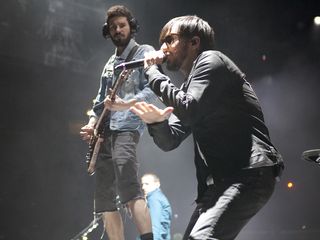
With Bennington in the background, Delson rocks on stage with Shinoda, 2011. © Paul Hebert/Corbis
"At the same time, there's vintage Gibsons and Fenders that we'll play around with, and we'll blend stuff together. Sometimes we'll process real guitar in ways that makes it not even sound like a guitar. For us in the studio, it's about creating handcrafted sounds that you haven't necessarily heard before." [See the end of this article for a complete list of the guitars and gear Delson used on LIVING THINGS.]
"Fortunately, because of where we are at this stage in our career, we do all of our writing and recording simultaneously. So we can actually be in a great studio - we did this record at NRG, and we'd be in Studio A, and different people would be in Studio B. Ostensibly, they're doing it more traditionally, where they've written the songs, demoed them and now they're going to track them. And they'll assume we're doing the same thing. Earlier in the process, we'd be in there writing or just making music. People would look at me and say, 'Oh, so you're recording, what are you tracking?' And I'd be like, 'No… not really.' [laughs]
"This happened with Minutes To Midnight, where we did have that mentality: 'The thing that we write can't be the thing that people hear. We have to perfect the engineering of it by redoing it.' Rick was really instrumental in A/B-ing stuff. I think it was The Little Things Give You Away, like, he listened to something Rob had in quotes 'recorded' over four days, and he did a blind A/B, and he said, 'I like this one better,' and it was the demo. Rob was like, 'Ahhh, what do you mean? I just spent four days creating that!' But Rick's ear said that the magic was in the original thing.
"That gave us the confidence to just write in the studio and make music, and preserve those moments of inspiration on the album. Ninety percent of the time, I'd say what you're hearing on the album is the initial spark of inspiration presented to the listener."
There's no one way songs get written, but is there something close to a pattern with Linkin Park - who starts something, who leaps on it?
"In our process, there are throughlines, because any one of the six of us can bring something in, and we'll always listen to everything together, physically in a room, once a week. There's no constrained way how it has to go, and so every song has a unique journey.
"I would say that Mike brings in the most ideas - he's the most self-assured in terms of the creation of sounds. He produced the record along with Rick. And then it's an open process for anyone to work on the songs and refine them. We tend to work a lot individually or in pairs within the Pro Tools sessions themselves, and we'll always discuss everything openly together at least once a week to make sure that if there's two versions of a song or if there's a 'newer version' - Rick has made us very aware that newer doesn't necessarily mean better."
You're featured as a vocalist on the song Until It Breaks. Very nice!
"Oh, thank you. That's kind of a coincidence that I'm on there vocally, in the sense that it wasn't intentional. That's one of the songs on the record that isn't so traditional in terms of the structure. It kind of has different suites, you might say. I think the inspiration was… is it Abbey Road where it has different movements?"
Yes, exactly. There's the extended medley on Side Two.
"OK, cool, so that was our inspiration. We actually had a bunch of ideas that, for whatever reason, didn't want to be full songs. But we loved the music that was there. So we built that around some of the songs that we had worked on earlier in the process that we wanted to put on the record, and we wanted to find a way to craft that all together.
"The first part where Chester is singing, the first refrain, that was an early demo that I just did in a day - it just was what it was, but it was a cool part for that section. Similarly, the end section was something I'd done up and everyone liked it, and I'd sung on it but it didn't feel like it belonged in the same breath as some of the real songs on the album, like Lost In The Echo or Burn It Down or In My Remains. Mike had the idea to just glue it onto the end of that piece. I had sung the vocals originally, and I think I re-sang them, but the spirit was definitely 'keep the vibe of the demo.'
"I don't consider myself a singer by any stretch, but I am comfortable, as all the guys are, singing harmonies and backing group vocals, and we'll do vocals on demos. It's just unusual to have something that's front and center."
The song Roads Untraveled has a bit of a folk vibe coming through.
"One of the dominant musical inspirations early on in the process was a folk influence. We had The Anthology Of American Folk Music, and we listened to a lot of that."
Skin To Bone has that feel, too.
"Skin To Bone has it and Castle Of Glass has it. I listened to a lot of those old folk songs for song structure, and I found that the A sections have the meat, and B is like a bridge or a departure and then you come back to the A; whereas in pop radio or hip-hop or rock for the most part these days, it's like the verse is always serving the chorus - the second thing is the hook. The songs you identified are structurally and inherently more of a folk form.
"We just loved that. A lot of it's major tonalities, built around the major root, but when you can do a major progression and still have it be sad or longing, I love how that sounds.
"I should also mention with the folk songs, one of our goals as Linkin Park was, 'What can we do to make it relevant?' Rick really challenged us: 'Well, if it has a folk DNA and you just present it as a folk song, that's not adding anything to the conversation.' So with Skin To Bone, for example, none of those sounds are folk sounds, and what makes it interesting to me is the juxtaposition of the arrangement versus the identity of what that song is. I think that's what makes it unique."

According to engineer Ethan Mates, who has worked with Linkin Park since 2006, Delson used a variety of guitars on LIVING THINGS. In addition to his Paul Reed Smith Custom 24, he also played a Fender Rory Gallagher Stratocaster, a Gibson ES-335, a mid-'70s Gibson Les Paul Junior, a mid-'70s Les Paul, and a couple of guitars belonging to Mates - a 1964 Stratocaster and a 1977 Gibson SG.
Amp-wise, Delson played through a Hiwatt Custom 100, an Orange Tiny Terror (with Holy Terror modification), a Fender Blues Junior and a Marshall Plexi.
For effects, Delson used, in Mates' words, "pretty much all of the Electro-Harmonix pedals at one place or another," although he cites the Memory Man, Holy Grail and the Hog as workhorse boxes. In addition, Delson employed three Devi Etter fuzz pedals, the Truly Beautiful Disaster, Torn's Speaker and the Shoegazer. Z.Vex pedals included the Super Hard-On, Whoolly Mammoth and the Mastotron. Rounding out the effects arsenal was a Fulltone Tape Echo.
Joe is a freelance journalist who has, over the past few decades, interviewed hundreds of guitarists for Guitar World, Guitar Player, MusicRadar and Classic Rock. He is also a former editor of Guitar World, contributing writer for Guitar Aficionado and VP of A&R for Island Records. He’s an enthusiastic guitarist, but he’s nowhere near the likes of the people he interviews. Surprisingly, his skills are more suited to the drums. If you need a drummer for your Beatles tribute band, look him up.

"Reggae is more freeform than the blues. But more important, reggae is for everyone": Bob Marley and the Wailers' Catch a Fire, track-by-track
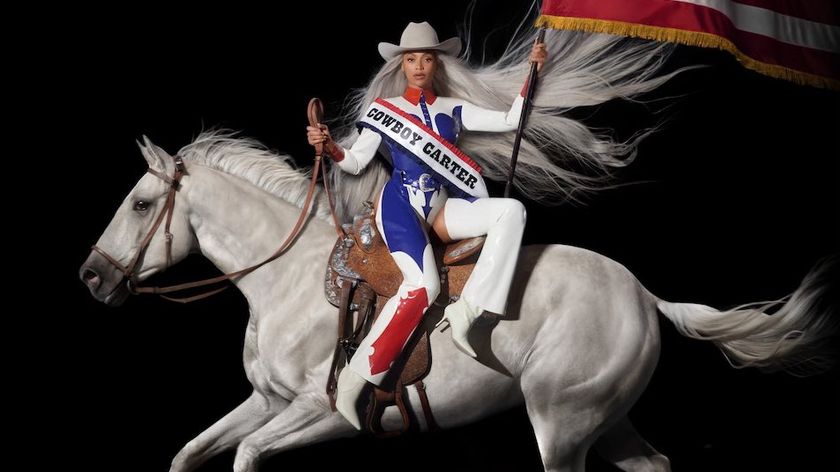
“Part of a beautiful American tradition”: A music theory expert explains the country roots of Beyoncé’s Texas Hold ‘Em, and why it also owes a debt to the blues


